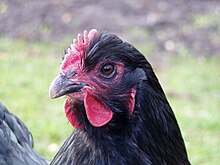Lutzomyia longipalpis
The species has recently begun appearing in urban areas throughout Brazil, and serves as a key vessel for the propagation of the parasite Leishmania infantum.
The first major urban outbreak of the lethal Visceral leishmanias epidemic was detected in Teresina, Piauí State in the early 1980s following a massive planting of acacias.
Earlier on, there were many doubts that L. longipalpis constituted a single species due to its wide geographic distribution over Latin America.
[5] L. longipalpis is the most abundant species of sandfly occupying northeastern Brazil, representing 97.9% of all phlebotomine sand flies present there.
This modulation in Trypsin activity after a sandfly's second blood meal is suspected to produce a conducive physiological environment for Leishmania infections, which is exploited by the parasite.
Higher levels of proinflammatory cytokines and chemokines were detected with a specific increase in the production of IFN-γ and IL-10, indicating a stronger and longer-lasting immune response to the disease antigen.
[9] Lutzomyia longipalpis females contain the ability to abruptly alter their physiology by switching the internal environment of the abdominal midgut from acidic to alkaline.
The presence of undigested proteins serves as the acting stimulus to drive female sand flies to undergo a shift in abdominal midgut pH.
Heme acts as a toxic molecule that can generate oxygen-reactive species and bypass membranes due to its high permeability.
[12] The direct bite of an infected sandfly during blood feeding allows for the parasitic transmission of Visceral leishmaniasis from L. longipalpis to the vertebrate host.
The sandfly saliva contains potent physiological compounds that cause anticoagulant, vasodilating, and anti-inflammatory activity, which influences the immune response of the host vertebrate.
Higher levels of proinflammatory cytokines and chemokines were detected with a specific increase in the production of IFN-γ and IL-10, indicating a stronger and longer-lasting immune response to the disease antigen.
Interestingly, the perturbation of the midgut microbiome due to the introduction of antibiotics causes the sand flies to become unable to support the parasitic growth of the pathogen.
The epidermis of chickens is relatively thin (~0.02 mm), which allows the sandfly to more easily pierce the skin to acquire the blood nutrients.
[12] From an evolutionary standpoint, one theory proposes that male blood-sucking L. longipalpis may have gained a significant mating advantage by staying near chickens and waiting for females to arrive and feed.
Dogs are commonly used as security to guard the chickens, which presents a convenient group of amplification hosts for the parasite within a concentrated area.
L. longipalpis follow a general life cycle common to sand flies consisting of eggs, larvae, and pupae, and winged adults.
[14] Immature stages involve growth in the ground, and soil traps have identified chicken sheds as the optimal breeding site for L. longipalpis larvae.
Both genders will consume sugar-rich foods, such as nectar, honey dew, and plant sap, but females will feed on a wide range of vertebrates, including dogs, chickens, horses, and humans.
[3] Several abiotic factors, such as temperature, rainfall, and humidity have been shown to influence the population density size of these sand flies.
[6] Because the diversity and quantity of plant wildlife are largely associated with the quality and availability of resources that insects can utilize, acacias have been targeted as a point of interest in their involvement with L. longipalpis and the propagation of its disease.



